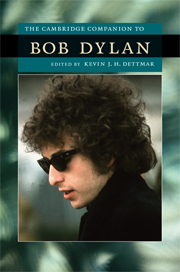Book contents
- Frontmatter
- Introduction
- Part I Perspectives
- 1 Bob Dylan and the Anglo-American tradition
- 2 Bob Dylan and Rolling Thunder
- 3 Bob Dylan as songwriter
- 4 Bob Dylan as performer
- 5 Bob Dylan and collaboration
- 6 Bob Dylan and gender politics
- 7 Bob Dylan and religion
- 8 Bob Dylan and the Academy
- 9 Bob Dylan as cultural icon
- Part II Landmark Albums
- Works cited
- Index
9 - Bob Dylan as cultural icon
from Part I - Perspectives
Published online by Cambridge University Press: 28 May 2009
- Frontmatter
- Introduction
- Part I Perspectives
- 1 Bob Dylan and the Anglo-American tradition
- 2 Bob Dylan and Rolling Thunder
- 3 Bob Dylan as songwriter
- 4 Bob Dylan as performer
- 5 Bob Dylan and collaboration
- 6 Bob Dylan and gender politics
- 7 Bob Dylan and religion
- 8 Bob Dylan and the Academy
- 9 Bob Dylan as cultural icon
- Part II Landmark Albums
- Works cited
- Index
Summary
In the early 1960s, popular musicians were often called “recording artists,” but they were not regarded by the press or the public at large as having a claim to making Art. From the middle of nineteenth century, the word “artist” was mostly reserved for painters, sculptors, writers, and composers, while the term “artiste” was sometimes used for actors and singers (Williams, Keywords 41). While in the US “artiste” evolved to mean something like “poser,” we continue to distinguish between art meaning any skill or craft - for example, the art of wine-making - and art (or Art) meaning works or the best works of visual artists, writers, or composers, and others such as filmmakers who increasingly are said to be artists. Art was a contested domain in the early 1960s, and that contest had grown in the post-war era. The elite embrace of modern art did not immediately produce popular acceptance of it, but more Americans were becoming familiar with what had been tastes restricted to a very small percentage of the population. The rapid growth of higher education in the 1950s was one factor. Another was the growth of the media, which made more people aware of art and artists, both the accepted and the marginal. Everyone knew something about the Beats, for example, even though most people never read their work. The public remained suspicious that artists were, like “beatniks,” lazy, slovenly radicals who refused “normal” work and family life. But they were also fascinated by the freedom these very characteristics seemed to entail, and, increasingly, by the strange new work such artists produced.
- Type
- Chapter
- Information
- The Cambridge Companion to Bob Dylan , pp. 110 - 122Publisher: Cambridge University PressPrint publication year: 2009
- 2
- Cited by



